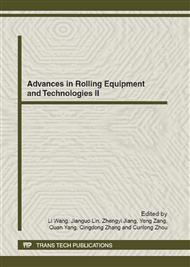p.1
p.7
p.13
p.19
p.25
p.31
p.37
p.43
Rolling Theory Analysis and Forces Calculation of Heavy Cylinder Rolling Mill with Two Drive Rolls
Abstract:
Took the heavy cylinder rolling mill as subject investigated, which is used to produce the nuclear power cylinder, the large hydrogenation reactor cylinder and the coal liquefaction reactor cylinder. And the cylinder rolling mill has two drive rolls which is different from conventional ring rolling mill. The rolling theory of heavy cylinder rolling mill was researched deeply based on mechanism method, including the biting condition, the plastic penetration condition, the feed condition and the feed velocity condition; the rolling force parameters of heavy cylinder rolling mill with two drive rolls were calculated based on the slip line method (SLM) and finite element method (FEM), and the simulation and industrial experiment were done; the influences of main technology parameters such as feed velocity, friction coefficient and temperature on the rolling force parameters were analyzed. The results show that the error of calculated rolling force and the measured value is less than 5%, which proves that the basic conditions deduced by theory method are correct, the models established based on SLM and FEM are correct. And with the increase of feed velocity, the rolling force increase, after a rolling circle, the rolling force fluctuates at a constant value; with the increase of friction coefficient, the rolling force increase; with the increase of initial temperature, the rolling force decrease.
Info:
Periodical:
Pages:
13-18
Citation:
Online since:
October 2012
Authors:
Price:
Сopyright:
© 2012 Trans Tech Publications Ltd. All Rights Reserved
Share:
Citation:


